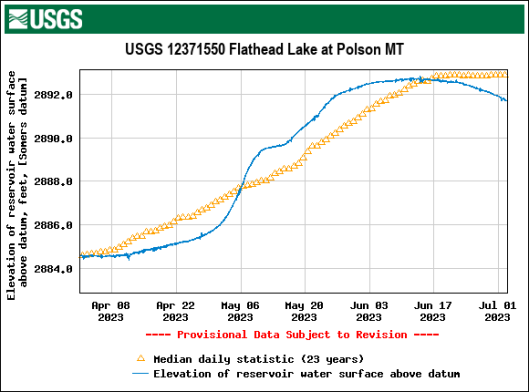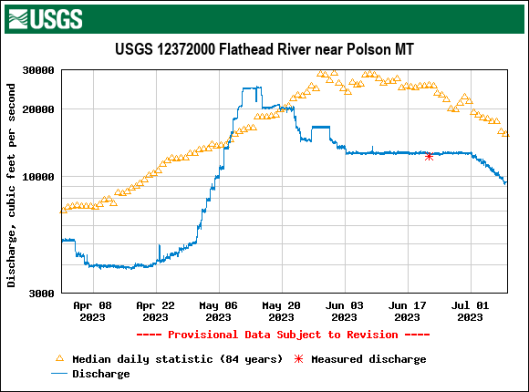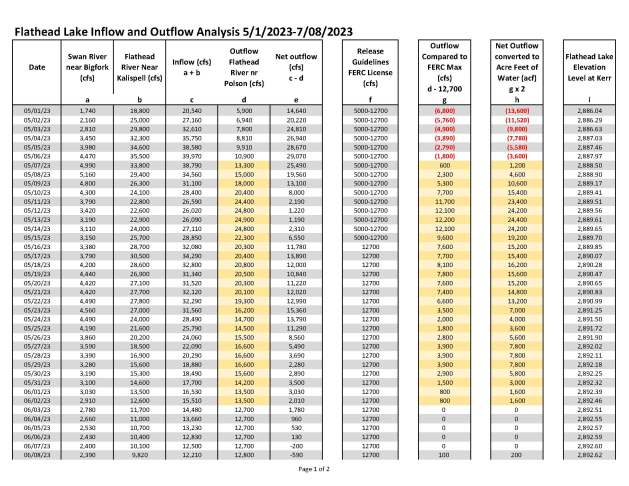© 2023 Concerned Citizens of Western Montana
Note: this article is in response to a comment submitted to us concerning our article about Kerr Dam that can be found at this link: Flathead Lake Levels: A Sleight of Dam?
Today we received this comment concerning our article questioning whether releases of water from Kerr Dam contributed to the Flathead Lake Shortages.
The Comment says this:
Your article does nothing except actually prove that the tribe was following their license. The minimum flows from June to July 1st are 12,700cfs. Your sheet shows they followed that to the letter. Except you chose to lead a misinformation campaign by omitting the most important part.
Here is the information you omitted taken directly from their license flow requirements.
May 16 to June 30 = Continuous at 12,700 cfs
July 1 to July 15 = Reduced from 12,700 cfs to 6,400 cfs at 420 cfs per day
Also shown in your data perfectly is they are reducing the flows 420cfs per day as required they can’t simply cut the flows to 6,400. They have to taper them down with daily limits;)
We agree with the commenter that the chart provided in the article shows that for the snapshot in time depicted, the tribe was releasing the volume of flows permitted by the FERC license.
We appreciate the commenter pointing this information out because it gives us the opportunity to now provide readers additional information concerning the weeks preceding June 13th when Flathead Lake levels actually began declining. These preceding weeks were not addressed in our original article.
In the context of a lake level crisis brewing as the news articles represented, our article questioned if the tribe could have reduced releases to protect the lake levels as well as preserve the important portion of Kerr Dam reservoir water necessary for irrigation purposes.
Certainly there must be some flexibility with respect to releases of water from the dam to accommodate both excesses and shortages based upon the FERC license guidelines. If nothing else, surely there is a FERC protocol that could have been followed to adjust the water releases from the dam.
We’d also like to remind folks that the original article included a link to the FERC license for everyone to see, and we are linking it again in this post: Kerr Dam FERC license
It is not our intent to disseminate misinformation to the public. We do our best to provide links to the context, and sources of information provided in our articles and sincerely hope that people delve into that information, just like the commenter did.
Over the years, we have diligently tried to provide the public with factual information about the Flathead Water Compact and the impacts it will have on the people of western Montana.
This has always been our mission and that has never changed. The Kerr Dam article is no different.
If we did anything incorrectly, it was by not providing readers with a larger timeline snapshot showing the impact of May – early June net flows through the lake via Kerr Dam releases.
The tribe’s ownership of Kerr Dam adds another layer of complexity to the picture, because due to their control of the dam, coupled with the various elements of the compact, the tribe is able to make decisions that can directly affect most of the water users living in western Montana.
With all of this in mind, we are providing you today with that larger snapshot of time that shows Flathead Lake could have been filled earlier, which in turn could have mitigated the risk of not being able to fill the lake to full pool. The diagram below shows the existing 2023 fill for Flathead Lake in comparison to the median lake levels based on a 23 year record.

Lets look at the corresponding current and median historic discharges from Kerr Dam for April through July 2023 as shown below for the Flathead River near Polson based on an 84-year record.

These graphs show that something far different than typical occurred in 2023. As shown in the first chart, the level of Flathead Lake peaked in early June instead of July as is typical. This chart shows that the runoff that could have been stored was released instead beginning in early May.
We have a friend who often tells us the genius in the way the United States developed the Flathead Irrigation and Power Project.
The Project was designed to ultimately be financially self sufficient, and was intended to provide a balance between irrigation water needs as well as the needs of the general public, including navigation of the lake and recreational purposes. Unfortunately in 1985 the BIA allowed the tribe to successfully decouple the power division from the irrigation project via an unlawful 638 contract, resulting in the diversion of a portion of the net power revenue derived from the low cost block of power away from irrigation and to tribal uses, rather than to maintenance of the project. This began the deterioration and demise of the project.
The BIA made it abundantly clear in the their May 15, 2023 Flathead Project meeting that the Flathead Project “is now a fishery project.” Does the shift shown in the graph signal the manifestation of that “policy” outcome of the compact for Flathead Lake?
It is the May – early June releases that could very well have made a difference between the lake reaching its full pool and the shortfalls we are currently experiencing. These same releases exceeded the FERC license restraints, but had they been more in line with the license restraints, could have averted the lake shortages.
This raises concerns that the Compact, coupled with tribal ownership of the dam allows them to do what they want.
Here are the data in a numbers tabulation that includes the Kerr Dam release guidelines as well as Flathead Lake elevation levels.
The photo above will link you to a expanded two page table detailing Flathead Lake Inflow and Outflow between May 1, 2023 – July 8, 2023 using the latest USGS figures.
It highlights 27 days of water releases that exceeded FERC release guidelines. It also shows that beginning on July 1, 2023, the tribe began lowering releases as per the FERC license guidelines.
The conversion of the excess water released from cubic feet per second to acre feet, also shows that the volume of “excess” water releases is very close to the 229,383 of Flathead Compact System Water awarded to the United States / CSKT in Appendix 9 of the compact. While we can’t know if the tribe took its Flathead Compact System water during this period, what we are seeing is the same effect as if they had, resulting in an approximate two foot reduction in the Flathead Lake level.
Again, our sincerest thanks to the commenter for reminding us to be more careful with respect to the snapshot in time we should have depicted to better show what took place with Kerr Dam releases and Flathead Lake levels during the spring and summer of 2023.
We also want to remind you that we are not saying that there aren’t water shortages in western Montana because of a natural drought weather pattern. We simply are questioning whether these effects could have been mitigated in order maintain Flathead Lake levels and to store water for irrigation needs later in the season. Since the Compact allows the CSKT to use this water at any time of the year and provides for no reporting, there is no possible way to know if this was a miscalculation, mismanagement, or if it was intentional.
None of this negates the serious questions that were asked in the original article concerning the ability to control levels of water that could create shortages of water through Kerr Dam releases and the future impacts if the water compact stands and its provisions are fully enforced.
If anything all of this should raise serious questions about the lack of accountability the compacting parties have with respect to the mess that they have created for western Montana.
Perhaps it is time to assess, yes, actually study the impacts and conflicts that are represented in the Flathead Water Compact, especially in light of the tribe’s ownership and control of Kerr Dam.


Pingback: Flathead Lake Levels: A Sleight of Dam? | Western Montana Water Rights
Thank you for all your efforts to keep everyone informed. I also appreciate the humility shown and always well written articles; as demonstrated with your response in addressing what appears to be a troll commenter trying to use partial information to discredit your last post. That’s how to win; by giving mass doses of the facts. Truth ALWAYS wins!
GUNNER
There are moral situations where it is immoral to say nothing and basely immoral to do nothing.~ A. W. Tozer
Thank you Gunner.
Often it’s difficult to balance how much information is too much, or in this case not quite enough.
We are simply concerned citizens that know something is horribly wrong in Montana and are doing our best to get word out about it.
We are blessed to be in this place, at this moment in time, to fight this battle.
Gunner,
My thoughts exactly!